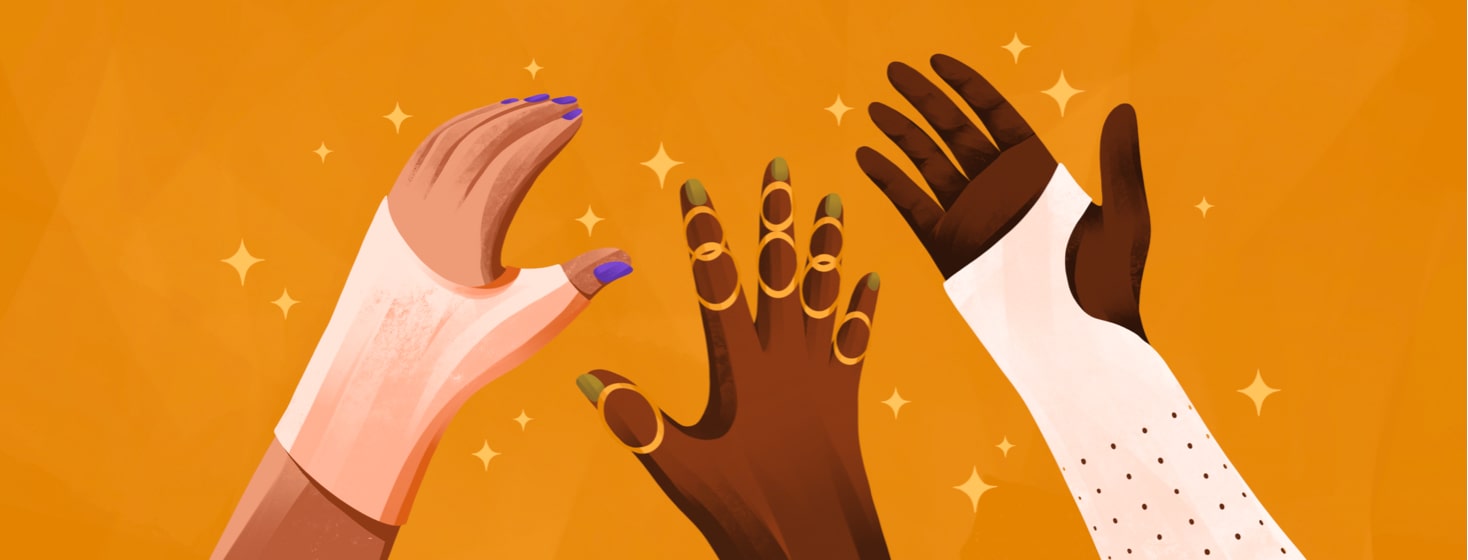Happy for Hand Therapy
When I was growing up with juvenile rheumatoid arthritis (now juvenile idiopathic arthritis or JIA), my favorite therapy was hand therapy.
There are a lot of reasons. I enjoyed doing things with my hands and therapy always seemed to involve a lot of arts and crafts, not just repetitive exercises (though that also had a role). Although I have significant weakness and joint deformities in my hands, therapy wasn’t as challenging on them as physical therapy for other areas such as the legs, where every step could be a combination of scary or painful.
Hand therapy has its benefits
Perhaps most of all, hand therapy included spa-like soothing treatments. I absolutely loved the hot paraffin wax treatment where we’d dip my hands and forearms in the bubbly hot goo, wrap them up in towels, and sit to let the heat seep into my bones. It was marvelous. And afterward, the oil in the wax made my hands all soft.
This was especially a treat in those cold winter months where I could never feel warm, my hands always felt clunky and stiff, and my skin as dry as the wintry winds.
So when my rheumatologist suggested I try a course of hand therapy for some reoccurring issues, I jumped at the chance. It had been possibly decades since I had gone and I also wondered if they would be doing anything new that I hadn’t seen before.
Starting with an assessment
Funnily enough, my primary issue for seeking some treatment wasn’t actually my hands — it was my neck and shoulder area! But the same type of therapist works on both, so I was able to present a list of problems and work on them over a series of sessions.
During the first appointment, I answered questions about my history and the therapist looked at my range of motion, tested my strength (gasped in abject horror), and asked me about the problems I was experiencing and wanted to address.
Improved arm and neck positioning
I was having significant neck pain and left shoulder pain that I couldn’t figure out myself. The therapist almost immediately determined (with some photos taken at home by my husband) that my work setup and posture were having a huge negative impact on my neck and left shoulder. As a lefty, I had my mouse on that side and was leaning over and crouching while working.
We devised a better desk setup by lowering my keyboard and raising the computer screen so that my arm and neck were better positioned (more level across the shoulders) to put less strain on my body and maintain a better posture.
Additionally, I felt better quickly by doing some exercises she showed me to strengthen and relax certain muscles in my neck and shoulders. It amazed me that such simple solutions could so quickly ease my pain and resolve a worsening issue!
Pain relief with custom wrist splints
Next, we worked on my wrists. Unfortunately, they are fairly locked into a slightly bent position and sometimes give me pain (especially my right) when I am using my arm muscles for any length of time.
I explained that, as a teen, I had some nighttime wrist splints that were really helpful in supporting my wrists while I sleep and reducing my pain when they are acting up. But I had long outgrown them and discarded them.
No worries! Out comes some plastic-like sheets that can be bent after being warmed in hot water, cut to size, shaped to my wrists until they cool, then velcro and fabric straps added. Just like that, I had new custom wrist splints and felt so much better after just a couple of nights' use.
Plus, when I’m having a bad wrist day, I can slip it on and get some extra support to reduce the aching.
Of course, the therapist also taught me some wrist strengthening exercises I can do to maintain my strength as best as possible. Along with the new neck, shoulder, and hand exercises, I feel like I have a much better routine for supporting these joints.
A better-fitting finger splint
Last, but not at all least, the therapist measured me and ordered me a finger splint. After so many years with severe RA, I have a few fingers with the swan’s neck deformity. It limits the bending of the joint which, unfortunately, I have gotten used to yet seem to manage.
But one finger, in particular, was having pain in the joint from the deformity. I had ordered a temporary splint online that wasn’t quite the proper fit, but in a pinch had reduced my discomfort.
The therapist thought I would be more comfortable with a better-fitted ring and she was very right about that.
Every RA patient has unique stressors on their body, but it’s true that we all use our hands to get through the day and get things done. Taking some time to get some hand therapy (or arm, neck, and shoulders!) can greatly improve our comfort and ability to maintain our strength in these areas.

Join the conversation